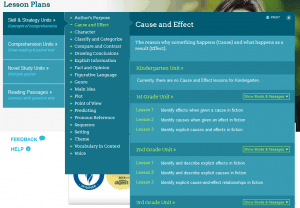Common Core Reading Lessons: Cause & Effect

The reason why something happens (Cause) and what happens as a result (Effect).
First Grade - Lessons: Identify effects when given a cause in fiction. 2) Identify causes when given an effect in fiction. 3) Identify explicit causes and effects in fiction.
Second Grade - Lessons: Identify and describe explicit effects in fiction. 2) Identify and describe explicit causes in fiction. 3) Identify explicit cause-and-effect relationships in fiction.
Third Grade - Lessons: Use signal words (if, then, because, since, so, before, after) to show cause-and-effect relationships. 2) Describe implicit effects when given a cause. 3) Identify implicit cause-and-effect relationships in nonfiction.
Fourth Grade - Lessons: Use signal words (as a result, until, therefore, hence, consequently, for this reason) that show cause-and-effect relationships in expository texts. 2) Identify multiple causes and effects in historical fiction. 3) Identify cause-and-effect relationships in myths.
Fifth Grade - Novel units.
Sixth Grade - Novel units.
CCSS.ELA-Literacy.RL.1.1
Ask and answer questions about key details in a text.
CCSS.ELA-Literacy.RL.1.2
Retell stories, including key details, and demonstrate understanding of their central message or lesson.
CCSS.ELA-Literacy.RL.1.7
Use illustrations and details in a story to describe its characters, setting, or events.
CCSS.ELA-Literacy.RL.2.1
Ask and answer such questions as who, what, where, when, why, and how to demonstrate understanding of key details in a text.
CCSS.ELA-Literacy.RL.2.2
Recount stories, including fables and folktales from diverse cultures, and determine their central message, lesson, or moral.
CCSS.ELA-Literacy.RL.2.3
Describe how characters in a story respond to major events and challenges.
CCSS.ELA-Literacy.RL.3.2
Recount stories, including fables, folktales, and myths from diverse cultures; determine the central message, lesson, or moral and explain how it is conveyed through key details in the text.
CCSS.ELA-Literacy.RL.3.3
Describe characters in a story (e.g., their traits, motivations, or feelings) and explain how their actions contribute to the sequence of events
CCSS.ELA-Literacy.RL.3.5
Refer to parts of stories, dramas, and poems when writing or speaking about a text, using terms such as chapter, scene, and stanza; describe how each successive part builds on earlier sections.
CCSS.ELA-Literacy.RI.3.2
Determine the main idea of a text; recount the key details and explain how they support the main idea.
CCSS.ELA-Literacy.RI.3.3
Describe the relationship between a series of historical events, scientific ideas or concepts, or steps in technical procedures in a text, using language that pertains to time, sequence, and cause/effect.
CCSS.ELA-Literacy.RL.4.3
Describe in depth a character, setting, or event in a story or drama, drawing on specific details in the text (e.g., a character's thoughts, words, or actions).
CCSS.ELA-Literacy.RI.4.2
Determine the main idea of a text and explain how it is supported by key details; summarize the text.
CCSS.ELA-Literacy.RI.4.3
Explain events, procedures, ideas, or concepts in a historical, scientific, or technical text, including what happened and why, based on specific information in the text.
CCSS.ELA-Literacy.RI.5.2
Determine two or more main ideas of a text and explain how they are supported by key details; summarize the text.
CCSS.ELA-Literacy.RI.5.3
Explain the relationships or interactions between two or more individuals, events, ideas, or concepts in a historical, scientific, or technical text based on specific information in the text.
CCSS.ELA-Literacy.RI.6.8
Trace and evaluate the argument and specific claims in a text, distinguishing claims that are supported by reasons and evidence from claims that are not.